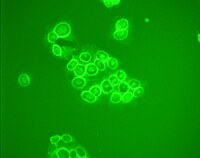OP145 Sigma-AldrichAnti-MDM2 (Ab-5) Mouse mAb (4B2C1.11)
This Anti-MDM2 (Ab-5) Mouse mAb (4B2C1.11) is validated for use in Immunoblotting, Immunofluorescence, Immunoprecipitation, Paraffin Sections for the detection of MDM2 (Ab-5).
More>> This Anti-MDM2 (Ab-5) Mouse mAb (4B2C1.11) is validated for use in Immunoblotting, Immunofluorescence, Immunoprecipitation, Paraffin Sections for the detection of MDM2 (Ab-5). Less<<Synonyms: Ant-Murine Double Minute Chromosome-2, Anti-Ubiquitin Protein Ligase, Anti-p53 Binding Protein
Recommended Products
Overview
| Replacement Information |
|---|
Key Specifications Table
| Species Reactivity | Host | Antibody Type |
|---|---|---|
| H | M | Monoclonal Antibody |
Pricing & Availability
| Catalog Number | Availability | Packaging | Qty/Pack | Price | Quantity | |
|---|---|---|---|---|---|---|
| OP145-100UG |
|
Plastic ampoule | 100 μg |
|
— |
| Product Information | |
|---|---|
| Form | Liquid |
| Formulation | In 50 mM sodium phosphate buffer, 50% glycerol, pH 7.5. |
| Positive control | A549 or MCF7 cells or breast carcinoma tissue |
| Preservative | None |
| Quality Level | MQ100 |
| Physicochemical Information |
|---|
| Dimensions |
|---|
| Materials Information |
|---|
| Toxicological Information |
|---|
| Safety Information according to GHS |
|---|
| Safety Information |
|---|
| Product Usage Statements |
|---|
| Packaging Information |
|---|
| Transport Information |
|---|
| Supplemental Information |
|---|
| Specifications |
|---|
| Global Trade Item Number | |
|---|---|
| Catalog Number | GTIN |
| OP145-100UG | 04055977224627 |
Documentation
Anti-MDM2 (Ab-5) Mouse mAb (4B2C1.11) SDS
| Title |
|---|
Anti-MDM2 (Ab-5) Mouse mAb (4B2C1.11) Certificates of Analysis
| Title | Lot Number |
|---|---|
| OP145 |
References
| Reference overview |
|---|
| Marchetti, A., et al. 1995. J. Pathol. 175, 31. Barak, Y., et al. 1993. EMBO. J. 12, 461. Ladanyi, M., et al. 1993. Cancer Res. 53, 16. Leach, F.S., et al. 1993. Cancer Res. 53, 2231. Oliner, J.D., et al. 1993. Nature 362, 857. Momand, J., et al. 1992. Cell 69, 1237. Oliner, J.D., et al. 1992. Nature 358, 80. Fakharzadeh, S.S., et al. 1991. EMBO J. 10, 1565. |








